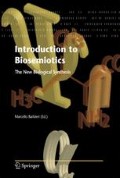Abstract
Semiotic theory has often been burdened by terminological inconsistencies and especially by the use of concepts and definitions in idiosyncratic ways. This paper aims to provide a framework for eliminating such inconsistencies and idiosyncracies by putting forward a simple system of terms based on Modeling Systems Theory, as developed by the late Thomas A. Sebeok, that takes into account semiotic behavior across species. The four basic forms proposed here (singularized, composite, cohesive, and connective) are defined, illustrated, and defended as solutions for standardizing semiotic terminology and for bringing general semiotic theory more in line with the biosemiotic movement
Access this chapter
Tax calculation will be finalised at checkout
Purchases are for personal use only
Preview
Unable to display preview. Download preview PDF.
References
Barbieri, M. (1985). The Semantic Theory of Evolution. London: Harwood Academic Publishers.
Barbieri, M. (2003). The Organic Codes. An Introduction to Semantic Biology. Cambridge: Cambridge University Press.
Barthes, R. (1977). Elements of Semiology. New York: Atlantic Books.
Bloomfield, L. (1933). Language. New York: Holt, Rinehart, and Winston.
Carnap, R. (1956 [1947]). Meaning and Necessity: A Study in Semantics and Modal Logic. Chicago: University of Chicago Press.
Danesi, M. (2003). Poetic Logic: The Role of Metaphor in Thought, Language, and Culture. Madison, WI: Atwood Publishing.
Deely, J. (2001). Four Ages of Understanding: The First Postmodern Survey of Philosophy from Ancient Times to the Turn of the Twentieth Century. Toronto: University of Toronto Press.
Deely, J. (2003). Why Semiotics? Ottawa: Legas Press.
Eco, U. (1978). Semiotics: A Discipline or an Interdisciplinary Method. In: A. Sebeok (ed.), Sight, Sound, and Sense, 73–88. Bloomington: Indiana University Press.
Ennion, E. R. and Tinbergen, N. (1967). Tracks. Oxford: Oxford University Press.
Fauconnier, G. and Turner, M. (2002). The Way We Think: Conceptual Blending and the Mind’s Hidden Complexities. New York: Basic.
Florkin, M. (1974). Concepts of Molecular Biosemiotics and Molecular Evolution. In M. Florkin and E H. Stotz (eds.), Comprehensive Biochemistry, Molecular Evolution, 1–124. Amsterdam: Elsevier.
Frege, G. (1879). Begiffsschrift eine der Aritmetischen nachgebildete Formelsprache des reinen Denkens. Halle: Nebert.
Friedmann, H. (1955). The Honey-Guides. U.S. National Museum Bulletin 208. Washington, D.C.: Smithsonian.
Gibbs, R. W. (1994). The Poetics of Mind: Figurative Thought, Language, and Understanding. Cambridge: Cambridge University Press.
Goatley, A. (1997). The Language of Metaphors. London: Routledge.
Greimas, A. J. (1987). On Meaning: Selected Writings on Semiotic Theory. P. Perron and F. H. Collins (trans.). Minneapolis: University of Minnesota Press.
Haldane, J. B. S. (1955). Animal Communication and the Origin of Human Language. Science Progress 43, 385–401.
Hoffmeyer, J. (1996). Signs of Meaning in the Universe. Bloomington: Indiana University Press.
Huxley, J. (1966). A Discussion of Ritualization of Behaviour in Animals and Men. Philosophical Transactions of the Royal Society of London 251, 247–526.
Jacob, F. (1974). The Logic of Living Systems: A History of Heredity. London: Allen Lane.
Jakobson, R. (1970). Language in Relation to Other Communication Systems. In C. Olivetti (ed.), Linguaggi nella società e nella tecnica, 3–16. Milano: Edizioni di Comunità.
Johnson, M. (1987). The Body in the Mind: The Bodily Basis of Meaning, Imagination and Reason. Chicago: University of Chicago Press.
Kloft, W. (1959). Versuch einer Analyse der Trophobiotischen Beziehungen von Ameisen zu Aphiden, Biologische Zentralblatt 78, 863–870.
Lakoff, G. (1987). Women, Fire and Dangerous Things: What Categories Reveal about the Mind. Chicago: University of Chicago Press.
Lakoff, G. and Johnson, L. (1980). Metaphors We Live By. Chicago: Chicago University Press.
Lakoff, G. and Johnson, M. (1999). Philosophy in the Flesh: The Embodied Mind and Its Challenge to Western Thought. New York: Basic.
Lakoff, George and Núñez, R. E. (2000). Where Mathematics Comes From: How the Embodied Mind Brings Mathematics into Being. New York: Basic Books.
Locke, J. (1690). An Essay Concerning Human Understanding. London: Collins.
Lotman, Y. (1991). Universe of the Mind: A Semiotic Theory of Culture. Bloomington: Indiana University Press.
Nöth, W. (1990). Handbook of Semiotics. Bloomington: Indiana University Press.
Ogden, C. K. and Richards, I. A. (1923). The Meaning of Meaning. London: Routledge and Kegan Paul.
Osgood, C. E., Suci, G. J., and Tannenbaum, P. H. (1957). The Measurement of Meaning. Urbana: University of Illinois Press.
Peirce, C. S. (1931–1958). Collected Papers. Cambridge, Mass.: Harvard University Press.
Pitts, W. and McCulloch, W. S. (1947). How We Know Universals: The Perception of Auditory and Visual Forms. Bulletin of Mathematical Biophysics 9, 127–149.
Posner, R. Robering, K., and Sebeok, T. A. (eds.) (1997–2004). Semiotik/Semiotics. Ein Handbuch zu den zeichentheoretischen Grundlagen von Natur und Kultur/A Handbook on the Sign-Theoretic Foundations of Nature and Culture, 4 vols. Berlin–New York: Mouton de Gruyter.
Quine, W. V. O. (1953). From a Logical Point of View. Cambridge: Harvard University Press.
Rowell, T. (1972). The Social Behaviour of Monkeys. Harmondsworth: Penguin.
Saussure, F. de. (1916). Cours de linguistique générale. Paris: Payot.
Sebeok, T. A. (1963). Communication among Social Bees; Porpoises and Sonar; Man and Dolphin. Language 39, 448–466.
Sebeok, T. A. (1972). Perspectives in Zoosemiotics. The Hague: Mouton.
Sebeok, T. A. (1994). Signs: An Introduction to Semiotics. Toronto: University of Toronto Press.
Sebeok, T. A. (2001). Global Semiotics. Bloomington: Indiana University Press.
Sebeok, T. A. and Danesi, M. (2000). The Forms of Meaning: Modeling Systems Theory and Semiotics. Berlin: Mouton de Gruyter.
Thom, R. (1975). Structural Stability and Morphogenesis: An Outline of a General Theory of Models. Reading: W.A. Benjamin.
Uexküll, J. von (1909). Umwelt und Innenwelt der Tierre. Berlin: Springer.
Author information
Authors and Affiliations
Editor information
Editors and Affiliations
Rights and permissions
Copyright information
© 2008 Springer Science+Business Media B.V.
About this chapter
Cite this chapter
Danesi, M. (2008). Towards a Standard Terminology for (Bio)Semiotics. In: Barbieri, M. (eds) Introduction to Biosemiotics. Springer, Dordrecht. https://doi.org/10.1007/1-4020-4814-9_12
Download citation
DOI: https://doi.org/10.1007/1-4020-4814-9_12
Publisher Name: Springer, Dordrecht
Print ISBN: 978-1-4020-4813-5
Online ISBN: 978-1-4020-4814-2
eBook Packages: Biomedical and Life SciencesBiomedical and Life Sciences (R0)

